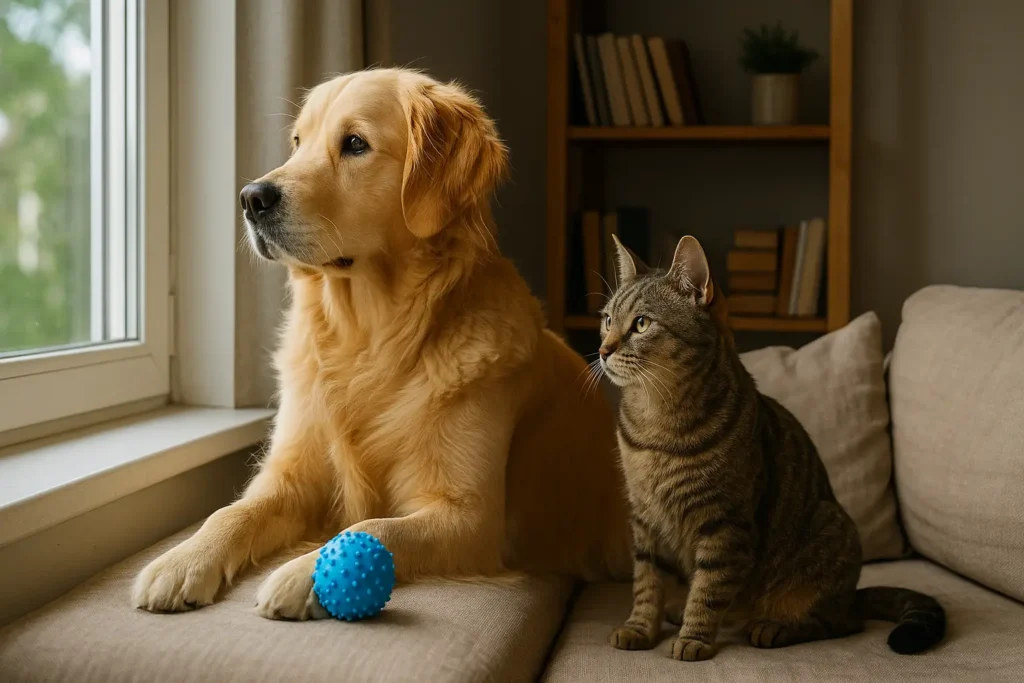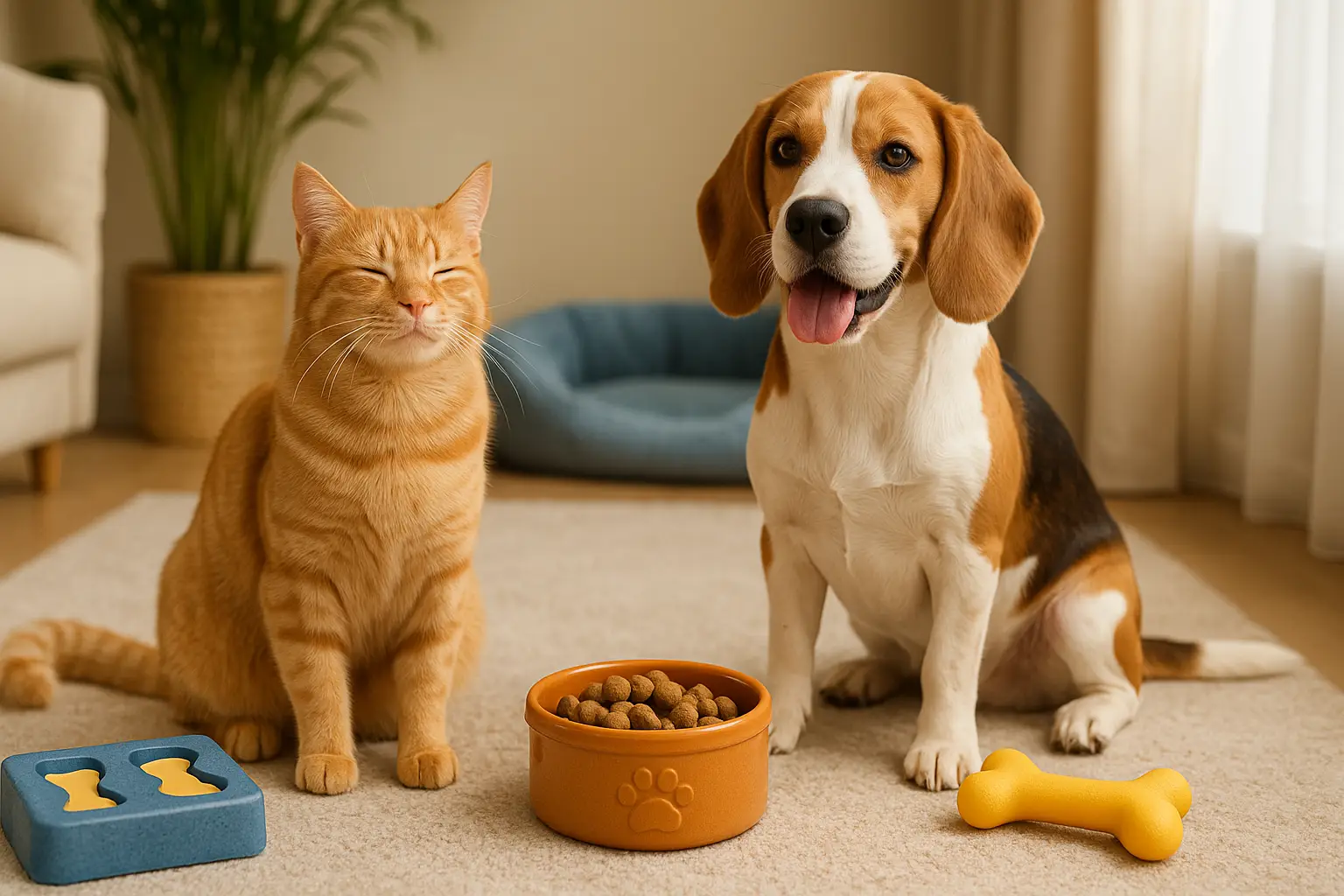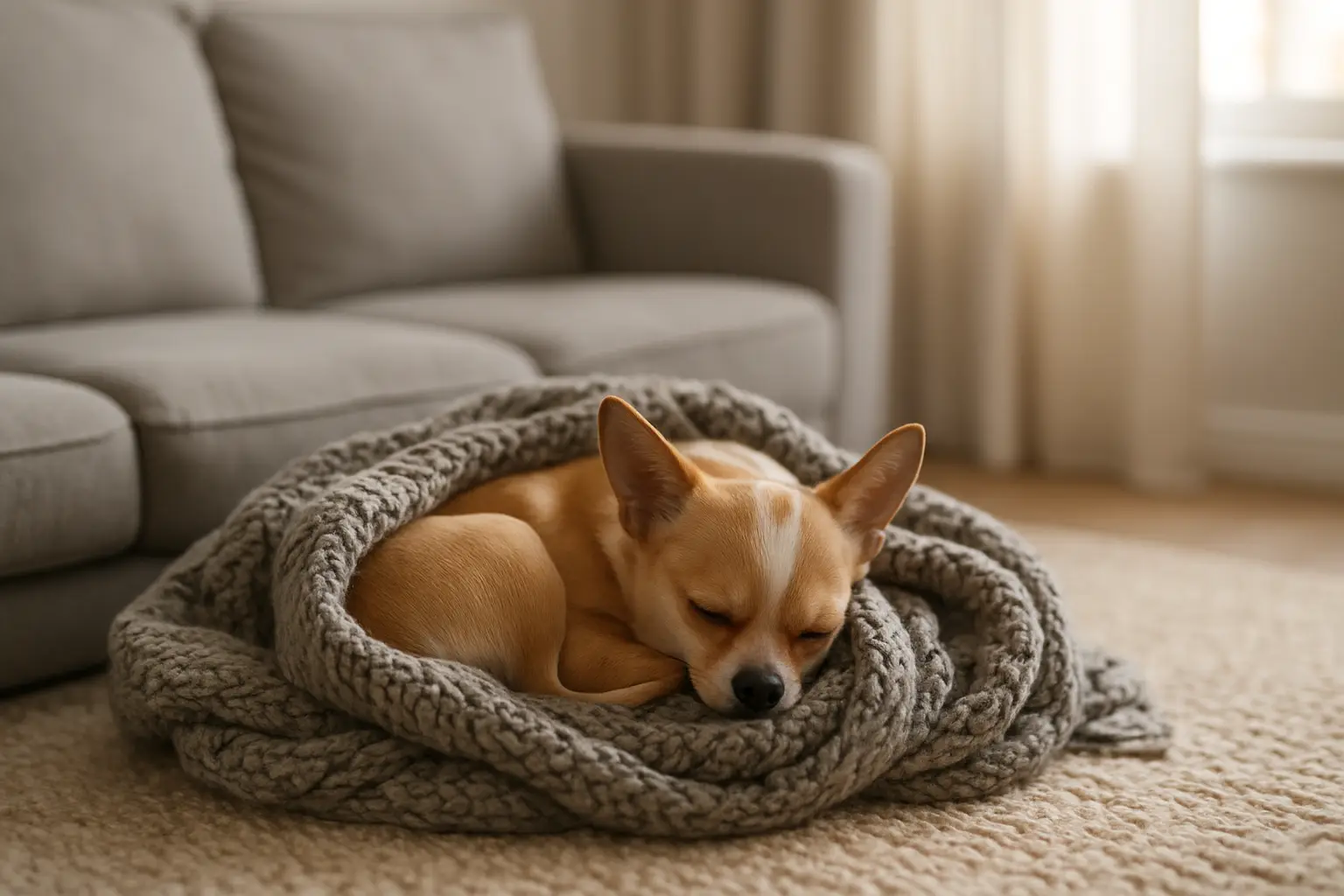How to Prevent Boredom in Pets When You’re Not Home 🐶🐱🏠
You love your pet. You’d stay home with them every day if you could—but work, errands, and life call. And when you’re out, your furry companion is left behind… waiting.
For dogs and cats, especially those with a strong emotional bond to their humans, this can lead to long hours of inactivity, frustration, and boredom. Over time, that boredom may evolve into problem behaviors like:

- Excessive barking or meowing
- Scratching furniture or doors
- Chewing inappropriate items
- Overgrooming or lethargy
- Anxiety or depression
But here’s the good news: even if you’re gone for hours, you can set up a home environment that keeps your pet mentally stimulated, emotionally balanced, and behaviorally healthy.
Let’s explore practical, creative, and realistic ways to keep your pet engaged while you’re away.
Understanding Pet Boredom: What’s Really Going On? 🧠
Boredom in pets isn’t just about having “nothing to do.” It’s about a lack of purpose, stimulation, and variation in their day.
Animals—like people—thrive when they have:
- Opportunities to explore
- Problem-solving activities
- Physical movement
- Access to stimulating sounds, smells, and sights
- Predictable rhythms and routines
When those elements are missing, pets create their own stimulation—which may not be what you had in mind.
Setting the Stage Before You Leave 🛫
Before you walk out the door, a few simple habits can go a long way in setting the tone for your pet’s day.
Morning Ritual for Calmness:
- Feed breakfast at the same time daily
- Allow for a 15–30 minute walk (for dogs) or interactive play session (for cats)
- Use a calming voice and body language as you prep to leave
- Avoid dramatic goodbyes—this can build anxiety
🧘 WordPress Block Tip: Add a “Morning Routine Checklist” printable for users to create calm energy before departure.
When your pet starts the day tired and fulfilled, they’re far more likely to nap, relax, and self-entertain while you’re out.
Creating an Enrichment-Filled Environment 🌟
Your home can become a playground of self-directed activity—even when you’re not there.
Toy Rotation System 🎾
Rather than leaving out every toy all the time, create a rotation:
| Day of Week | Featured Toy Type |
|---|---|
| Monday | Chew toy + scent toy |
| Tuesday | Puzzle feeder + plush |
| Wednesday | Treat-dispensing ball |
| Thursday | Catnip mouse or kicker toy |
| Friday | Audio toy or crinkle mat |
🎁 Store extras in a “toy vault” box. Rotate 1–2 toys each day to keep things fresh.
Puzzle Feeders: Mental Workout During Mealtime 🧩
Turning meals into challenges transforms food time into playtime.
Best Types of Puzzle Feeders:
- KONG Toys: Stuff with peanut butter, yogurt, or wet food and freeze.
- Snuffle Mats: Hide dry food among the folds for dogs or cats.
- Maze Bowls: Slow down eating and make pets work for kibble.
- Sliding Trays: Great for cats to swipe open hidden treat compartments.
- Lick Mats: Soothe anxiety with spreadable treats.
🐕 Include a “Top 5 Puzzle Feeders Reviewed” block with images and links.
Create a Pet TV or Audio Experience 📺🎧
Your pet doesn’t need a Netflix account—but some quiet background sound can reduce stress and mimic companionship.
Options to Try:
- Pet TV on YouTube (birds, squirrels, fish, calming motion)
- Classical or soft ambient music playlists
- White noise machines (especially helpful in cities)
- Audiobooks or radio talk (for human voices)
- Furry Friends Radio (specially composed music for pets)
📻 Add a “Pet Playlist of the Week” block where users can embed their Spotify or YouTube mix.
Safe Window Access and Outdoor Views 🌄
Windows provide endless entertainment: movement, light, animals, and the rhythm of the world outside.
Setup Ideas:
- Place a cat tree, window perch, or bench near a safe window
- Use suction cup hammocks for cats
- Place a bird feeder outside for occasional bird-watching
- Ensure the screen is secure!
🪟 For apartments, include a “Balcony Window Safety Tips” section with checklists for securing your pet’s view.
Comfort Zones: Making Rest a Reward 🛏️💤
Comfort is its own form of enrichment. Pets need cozy places to retreat, especially during long solo hours.
Features of a Great Rest Spot:
- Elevated or enclosed for a sense of security
- Familiar bedding with your scent
- Slightly away from main door or foot traffic areas
- Near natural light (but not in direct sun all day)
- Calm ambient temperature—never too hot or cold
🐾 Add a “Top 5 Beds for Anxious Pets” review block or affiliate widget
Set Up a Scent Adventure 🐽
Your pet’s nose is their strongest sense. You can use scent to make their world exciting—even when it’s still.
Scent Enrichment Ideas:
- Hide treats in unusual spots (under couch cushions, blankets)
- Add lavender sachets (calming) or rosemary sprigs (stimulating)
- Rotate your own clothing items for emotional comfort
- Use scent trails (rub treats on objects to encourage search)
👃 Add a “DIY Scent Game” block with steps for hiding treats or toys
Tech Tools to Monitor and Entertain Remotely 📱
Modern pet parents have tons of tech to stay connected even while away.
Top Devices:
- Pet Cameras (e.g., Furbo, Petcube)
Watch, talk to, or toss treats to your pet in real-time. - Automatic Toys
Timed movement or sound-based toys activate throughout the day. - Auto Feeders
Schedule meals and snacks for structure and control. - Interactive Laser Toys
Remote-controlled or app-based—keep your cat engaged in real-time.
📲 Add a “Smart Home for Pets” block comparing features of each device.
DIY Activities Before You Leave ✂️🎉
Some last-minute tricks can keep your pet occupied for hours.
Quick DIY Ideas:
- Frozen banana & kibble in a silicone mold
- Treats in an egg carton taped closed
- Cardboard toilet paper roll with kibble inside, pinched ends
- Treats inside a rolled towel puzzle
- Stuffed muffin tin (tennis balls over treats in each slot)
🎨 Add a “5-Minute DIY Enrichment” carousel block with quick setup visuals
Separation Anxiety vs. Simple Boredom 🧠💔
Not all alone-time distress is boredom. Some pets struggle with actual separation anxiety, which is a medical and behavioral condition.
Signs of Separation Anxiety:
- Panic when you prepare to leave
- Destructive behavior focused near doors or windows
- Excessive salivation or vocalization
- Refusal to eat when alone
- Soiling despite being house-trained
🧠 If you suspect separation anxiety, consult a vet or certified behaviorist. Boredom strategies alone won’t solve the problem—but they can help reduce frustration.
📖 Add a “Separation Anxiety vs. Boredom” visual block to help readers assess their pet.
When You’re Gone Longer: Pet Sitters & Daycare 🏡🐕🦺
Sometimes enrichment isn’t enough—your pet just needs company.
Solutions for Long Days:
- Hire a midday dog walker or sitter
- Use a pet-sitting app like Rover or Wag
- Enroll your dog in a few days/week of daycare
- Ask a trusted neighbor to drop by
- For cats: use a treat camera or interactive play while you’re at work
🤝 Add a “Pet Sitter Interview Guide” block with questions and vetting tips.
Final Thoughts: Alone, But Not Lonely 🐾❤️
Boredom doesn’t have to be part of your pet’s daily life. With a bit of thought, creativity, and setup, your home can offer comfort, challenge, and joy—even when you’re not there.
By rotating toys, using scent and sound, offering food puzzles, and maintaining rhythm, your pet stays stimulated, grounded, and happy.
Because when your pet has what they need to feel secure, they don’t just survive your absence—they thrive.




Post Comment